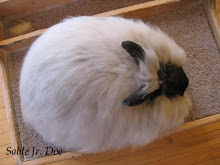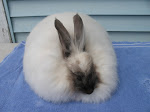To back up a little, the majority of rabbits in my breeding program do not molt. What I mean by this is that most do not ever get to the point where their wool is released totally, making it possible to pluck their coats. Most go into a long drawn-out slipping stage where their wool declines in quality and has to be removed by clipping. Many of them will drop bits of wool here and there in the cage pan when the time for a harvest is near, but none ever blow their coats completely to the point where it is falling off and the fluff is flying around 24/7, LOL. This is acceptable and exactly what I prefer my rabbits to do because they are bred for show before anything else, but it is different from what the original French Angoras were bred to do, and different from what many fiber breeders at the present time prefer their animals to do. My own feeling is that a rabbit that is sheared is healthier than one that is plucked, but this is my personal opinion.
When I first got into FAs, the first bunnies I had were serious pluckers. I was told to comb their wool out when they began to molt so I did, but later on I acquired different stock that did NOT molt easily, and the rabbits had to be clipped in order to harvest their wool. Clipping worked better for my management needs than combing/plucking because the rabbits could be bred to molt (or 'slip') on a schedule that coincided with the spring/fall show schedules. The wool could be removed all at once with no delay and less strain on my hands, and there were far fewer issues with woolblock in my herd. I began breeding more rabbits who did not 'molt' and I crossed those who did into the ones that didn't so the offspring gradually grew even coats as well. For several years I had 'tweens' in my herd who seemed to both molt and need clipping (if that makes sense), but most eventually evened out with several babies still cropping up with non-synchronized senior coats a couple times a year. At present, 95% of my herd are clipping rabbits (not counting the NZ crosses), but there is still a tiny core in the barn that leans more toward the plucking-style coats.
This rabbit shown below is one of my 'pluckers:)'. Her name is Althea which means 'Black Night', and she is an old line rabbit that I kept exclusively because of her excellent color. She was born dark with no white hairs, snips, or faded color, and she managed to keep this color throughout her 2 years, throwing it onto a beautifully colored litter that was kindled last spring. She is not a show rabbit as she does not have good type and can never grow wool densely enough to compete with the buns that are sheared, but I keep her in an effort to pass her color to the rest of the herd.
After reading a discussion on the FA List about plucking and clipping, I decided to let Althea revert back to her natural molt cycle to see how long it would last and whether she would really release her coat to the point where it could be harvested without any pull or resistance. In the past I have clipped her even though she grows back unevenly because her function has been solely as a breeder (I did not want her to go off feed or shed multiple coats, etc). This time I let her go for a period of 5 months during which I was able to see two distinct coats coming in. At the end of the 5th month there were two coats of two different ages present (one new and one just coming into molt), and at this point Althea began to consume less feed and drink less water. She continued to look healthy and move normally, but instead of 1 mounded cup of feed she scaled back to 3/4 cup. Soon thereafter the water consumption fell off, so I decided to remove both coats and give her a break before the next breeding.
This first picture below shows Althea after she came in and I set her on the grooming table. You can see the various lengths of different coats growing in here. The newer growth is much darker than the old.

I picked up a slicker brush and began brushing out her old coat. Within a few minutes of grooming the old growth COMPLETELY and totally released with no resistance whatsoever (I mean completely off and onto the floor!). I am convinced that Althea is indeed a full-fledged 'plucker' of the sort that was described in our FA list discussion:-).
Here is a picture of her back after I had brushed out most of the old coat, leaving a patch of new growth in the middle:

After brushing for awhile I then clipped her down completely, and you can still see the pattern of growth coming up beneath her skin.

Anyway, so this was an interesting demonstration of a true plucking-style FA that develops a coat in stark contrast to the shearing rabbits on the other end of the spectrum. Plucking vs. shearing makes for an interesting comparison that every FA breeder should have the chance to observe sometime. I have always said (and very strongly feel) that it is important for every person to know what they have in their breeding programs so that they do not wind up clipping rabbits that should be plucked, and vice versa. Every FA is different (especially nowadays), so it is vital to know what you have in your herd so your goals can be aligned with your functions.
Have a great week!:-)























3 comments:
Help educate me please!
1) The photo of the shorn rabbit is really startling! How can a rabbit with all those 'spots' have the even color that I've been given to understand show rabbits need?
2) Could you explain the 'tort' color to me? 'Tort' in other species means tortoise-shell, but these buns look like the color is only on their heads and legs.
3) Do all or most FAs have a lighter body color than the head and legs? The 'black' rabbits I have seen have gray, bluish or silver body fur.
Thanks !!!
Deb W
Hi Deb,
1) This is a rabbit with multiple coats coming in at different times, that is why the color is splotchy. Once a coat grows in on an angora it is tougher to see differences in color due to the length of the hair shaft. Also, some rabbits are naturally more even than others.
2) 'Tort' in rabbits is not the same as Tortoiseshell in a cat (for ex.). Tort angoras have Black, Blue, Chocolate, or Lilac masks, ears, feet, and tails, and a Fawn colored body.
3) All FAs (and all angoras, for that matter) have lighter bodies than heads because of the color that gets extended over a long hair shaft. The only way to identify the true color of an angora is to look at it's head. French and Satin angoras have more intense color on their bodies due to the greater proportion of guard hairs in their coats, and English are lighter because they have less.
HTH!
Amy:)
Overall your angora rabbits is really best.
Post a Comment